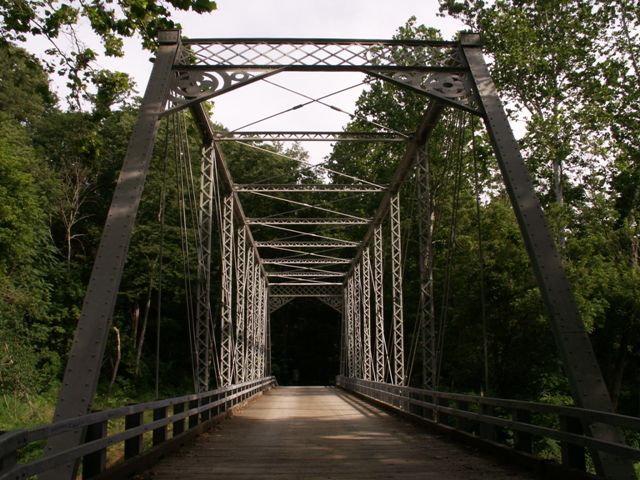We Recommend:
Bach Steel - Experts at historic truss bridge restoration.
BridgeHunter.com Phase 1 is released to the public! - Visit Now
Poffenberger Road Bridge

Primary Photographer(s): Nathan Holth and Rick McOmber
Bridge Documented: July 9, 2008
Rural: Frederick County, Maryland: United States
1878 By Builder/Contractor: Penn Bridge Company of Beaver Falls, Pennsylvania
2006
123.0 Feet (37.5 Meters)
126.0 Feet (38.4 Meters)
13.5 Feet (4.11 Meters)
1 Main Span(s)
200000F-2203010

View Information About HSR Ratings
Bridge Documentation
View Archived National Bridge Inventory Report - Has Additional Details and Evaluation
View Historic American Engineering Record (HAER) Documentation For This Bridge
HAER Data Pages, PDF
View The Historic Bridge Inventory Report For This Bridge
The Poffenberger Road Bridge is right off a very important bridge because it is an ancient 1878 structure displaying the uncommon Whipple truss configuration. Its age shows in its lightweight design. The vertical members and original rolled floorbeams on this bridge are surprisingly small on this bridge. However the bridge is far more than just that.
This bridge clearly displays numerous design details that immediately associate it with the Penn Bridge Company just as surely as a builder plaque (which is missing from the bridge) would. It does have some traits that the Wrought Iron Bridge Company also used, and this confused some people including those who conducted the state historic bridge inventory. However some other details on the bridge are unique only to Penn Bridge Company, it is those details that HAER and this website both used to arrive at Penn Bridge Company with extremely high confidence.
The Poffenberger Road Bridge features the unusual termination of the top chord at the end post that allows a small date plaque to be present at the end of the top chord. Another company did this also on its oldest Pratt truss bridges, the Wrought Iron Bridge Company. However the presence of two pins at the top chord / end post connections is something that is extremely unusual but something Penn Bridge Company did often. It is most similar in appearance and design to a smaller bridge in Michigan that is a Pratt rather than a Whipple, the Bauer Road Bridge. These two bridges share a distinctive portal knee bracing and a bottom chord whose eye bars are a single piece of fabricated iron for a length of two panels rather than the usual one panel. By the way, be sure to look closely at the knee bracing on these bridges. You will note the shapes are not "cut" smoothly, and instead have a jagged teeth-like edge to them. This is because they lacked machinery to simply cut the metal. Instead the shapes had to be laboriously cut out by punching or drilling tiny holes in the metal, like using a one hole-punch tool to cut a sheet of paper in half. This is the effort that companies went to just to make sure the bridge was not only functional, but was attractive as well.
A detail that is not shared with many other Penn Bridge
Company bridges that is present on this bridge is the fact that although they
went overkill with two pins at the top chord and end post, there are no pins for
the diagonals on the rest of the top chord connections. Instead the diagonals
terminate in a threaded rod which is held to the top chord by a large bolt. This
connection technique is something likely brought from the way members on
bowstring truss bridges like
Bennies Hill
Road Bridge were connected. The Wrought Iron Bridge Company is the only
other noteworthy company that continued using this unusual connection technique
beyond the bowstring era, employing it for some of their pony truss bridges.
As an extremely old 1878 example of a pin-connected truss bridge, as a bridge
with the unique design details of its builder, and as a bridge with the uncommon
Whipple truss configuration, the Poffenberger Road Bridge is an extremely
significant historic bridge that should continue to receive high preservation
priority.
![]()
Photo Galleries and Videos: Poffenberger Road Bridge
Bridge Photo-Documentation
Original / Full Size PhotosA collection of overview and detail photos. This gallery offers photos in the highest available resolution and file size in a touch-friendly popup viewer.
Alternatively, Browse Without Using Viewer
![]()
Bridge Photo-Documentation
Mobile Optimized PhotosA collection of overview and detail photos. This gallery features data-friendly, fast-loading photos in a touch-friendly popup viewer.
Alternatively, Browse Without Using Viewer
![]()
Maps and Links: Poffenberger Road Bridge
Coordinates (Latitude, Longitude):
Search For Additional Bridge Listings:
Bridgehunter.com: View listed bridges within 0.5 miles (0.8 kilometers) of this bridge.
Bridgehunter.com: View listed bridges within 10 miles (16 kilometers) of this bridge.
Additional Maps:
Google Streetview (If Available)
GeoHack (Additional Links and Coordinates)
Apple Maps (Via DuckDuckGo Search)
Apple Maps (Apple devices only)
Android: Open Location In Your Map or GPS App
Flickr Gallery (Find Nearby Photos)
Wikimedia Commons (Find Nearby Photos)
Directions Via Sygic For Android
Directions Via Sygic For iOS and Android Dolphin Browser
USGS National Map (United States Only)
Historical USGS Topo Maps (United States Only)
Historic Aerials (United States Only)
CalTopo Maps (United States Only)

